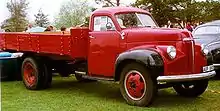| Studebaker M-series truck | |
|---|---|
 1946 Studebaker truck | |
| Overview | |
| Manufacturer | Studebaker |
| Production | 1938-1952 |
| Body and chassis | |
| Body style | 2-door pickup |
| Layout | Front engine, rear-wheel drive / four-wheel drive |
| Chronology | |
| Predecessor | Studebaker Truckette Studebaker Coupe Express |
| Successor | Studebaker 2R/3R |
The Studebaker M-series was a pickup truck series designed in the late 1930s by the Studebaker Corporation.
Production
The M-series Studebaker trucks came in several versions both pre and post WW II. The M-5 was a 1/2 ton truck, available in a pickup configuration as well as a cab and rolling chassis. The M15 was the 3/4 ton version. The M15A was the one & 1+1⁄2-ton version. The M5, M15, and M15A all came with the Champion 169 ci. engine only. The M16 1-1/2 & 2 ton versions came with the more powerful Commander 226 ci. engine. The Studebaker US6 version was produced during the war to government specifications; using a different nose and engine configuration, in both a 4x6 & 6x6 versions of a 2+1⁄2-ton truck. In early 1945, Studebaker was given permission to produce some M Series trucks for civilian use. These early post war civilian trucks used the Studebaker US6 cab with the government style swing out windshield.

Like most truck lines, the Studebaker M Series trucks could be had in any number of body styles. While only pickup beds were offered on the M5, M15, & M15A versions from the factory, combination cab and rolling chassi were sold, allowing custom truck body manufacturers to variously sell standard beds and boxes or custom fabricate them to an owners specifications.
While the M16 version used the larger Commander 226 ci. engine, through the use of a different fire wall on these cabs, all the other front sheet metal stayed the same. However, a spacer was used in the front fenders to accommodate the larger front wheel track of the M16.
First put into production in November 1940, it saw extensive action during the Second World War, specifically in the South East Asian theatre against Japan. In particular, these Studebaker US6 version of the M-series Studebaker trucks were used in the construction of the Burma road. A large number of these trucks also served in the Russian army forces as part of aid given to the country by the U.S.
Design and specifications
The M series sported a more aerodynamic shape than most trucks of the time, with easily recognisable "wind wing" vents on the driver and passenger windows, a feature not found on any other make of American truck during World War II. When Studebaker introduced the M-series pickup truck in 1941, the company used the Coupe Express name from its 1937–1939 Coupe Express coupe utility of in advertising for a time; no M-series trucks were ever officially designated as the Coupe Express.[1]
| Engine | The M5, M15, & M15A versions came only with the Champion 169 ci, engine.
The Commander “Big Six” 226 ci, engine w/ 6 blade shrouded fan was used only in the M16 version. |
|---|---|
| Transmission | T9 crash box 4 speed w/ drum emergency brake |
| Tire size | 8.25 x 20” |
| Wheelbase | 113" on M5 with 120", 128" & 152” on M15, M15A, & M16; a 195" was available on the M16 as well. |
Footnotes
- ↑ Studebaker truck data Archived 2007-02-28 at the Wayback Machine, retrieved on March 10, 2007